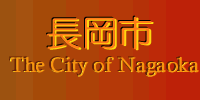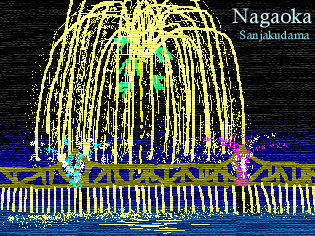
|
Index:
|
 I Love Nagaoka !
I Love Nagaoka !
Nagaoka is the second largest city in Niigata prefecture (located in middle-north of Japan). There are about 280,000 people in this city. It takes about 90 minutes from Tokyo to Nagaoka by Joetsu Shinkansen train. They have much snow in winter. There are very beautiful seasons' scenery. In summer, the greatest firework display in the world is held on the Shinano, the longest river in Japan. Nagaoka area is also famous for its good production of rice. The countryside view of big rice field around the suburbs of Nagaoka or a scenery of sunset on the shore of Sea of Japan is very fascinating.
 The history of Nagaoka -another modern history of Japan-
The history of Nagaoka -another modern history of Japan-
 A tragedy of Japanese civil war
A tragedy of Japanese civil war
Nagaoka has played very important role in Japanese history, but not so many people know about the story.
In Edo era, Nagaoka was a castle town of Nagaoka Clan. the lords of Nagaoka in the era were the Makinos.The Makinos had been in several important positions in the late shogunate era. In 1868, the Tokugawas' shogunate - it had anyhow governed Japan for 270 years without war - collapsed. Satsuma and Choshu Clans overthrew shogunate and set up new government. More and more clans formed alliances with Satsuma and Choshu. But wasn't it a kind of coup ? A General of Nagaoka Clan, Tsuginosuke Kawai, thought Nagaoka Clan should not be on their side, and attempted to make Nagaoka a neutral principality like some countries in Europe. As a matter of fact, he had an European acquaintance.
But Kawai's idea didn't come true. Satsuma and Choshu defeated Nagaoka Clan, and castle town was destroyed. Kawai was also killed in the war. It is regrettable that there is nothing to show the outlook of the historic castle in Nagaoka today.
After the war, Nagaokan people were forced to lead hard times. Mineyama Clan sent Nagaoka a hundred sacks of rice. Almost starving people delighted. But Nagaokan prime councilor, Torasaburo Kobayashi said to the people. "If we eat the rice, the rice will run out in a few days. I have an idea. I'd like to sell the rice to establish a school. It is a school for everyone."
Needless to say, people opposed him. However, Kobayashi never changed his mind. He thought it's the most important to make a good talent for the future of Nagaoka, Japan, or the world. At last, Nagaokan people agreed his idea.
The English translation of this story is also available (by Donald Keene).
 Tragedy again
Tragedy again
On December 8. 1941, the Navy of Japan attacked U.S. Navy in Pearl Harbor. But the Japanese Admiral, Isoroku Yamamoto had mixed feelings in his mind. Yamamoto was born and grew up in Nagaoka. He became a sailor, and was appointed an officer, commander. Even when he was appointed the admiral, he was also known as a typical liberalist in the navy. In fact, he was against the war with U.S. or U.K. from the first. He analyzed the powers of these countries carefully, and thought the war was "a long shot". It's said that actually he suggested his opinion to avoid the war to the government, but the government didn't take his words seriously. Yamamoto was killed in the battle in 1943, but his anxiety would come true.
Nagaoka was bombed in the World War II (on August 1. 1945; Nagaoka Air Raid). More than 1400 people were killed, and more than 80 percent of the city was destroyed. After the war, however, Nagaokan people started their reconstruction of the city on the ruins, and also started the firework festival as a symbol of the recovery. As a matter of fact, the fireworks in Nagaoka are a kind of prayer for the peace of Nagaokan people.
 Nagaoka Festival !
Nagaoka Festival !
 Let's go watching great fireworks display!
Let's go watching great fireworks display!

The best scene of Nagaoka in summer is its fireworks festival. Nagaoka is internationally famous for its great fireworks display. fireworks of Nagaoka were also set abroad (at the finale of the closing ceremony of Los Angeles Olympic games in 1984 etc.). Let's go watching one of the greatest fireworks in the world, beautiful fire artworks on summer evening sky!
- When?
- 2. and 3. August. (2 days) 19:30-21:30
- Where?
- near the bank of Shinano river, Nagaoka City. (about 20min. walk from JR Nagaoka Station (From Ote-guchi exit of the station, go along Ote-dori street.))
 How to get to Nagaoka Fireworks
How to get to Nagaoka Fireworks
- To Nagaoka
- From Tokyo, please take a Joetsu Shinkansen train (Bullet train; New Joetsu Line), superexpress "TOKI" (bound for Niigata). The train stops at Ueno, Omiya, Takasaki, Echigo-Yuzawa, and Nagaoka (some trains stop at more (or less) stations). It takes about 90min from Tokyo to Nagaoka by the Shinkansen train (fare:about 8200 yen ;Tokyo-Nagaoka, without seat reservation). Coming to Nagaoka by car during the festival is not recommended because of heavy traffic jams. And please note that arranging for your hotel reservation around Nagaoka City during the festival is very difficult.
 Highlights of the fireworks
Highlights of the fireworks
Starmines
A starmine is a program which is composed of a set of many fireworks. Hundreds of fireworks kindled within a minute show fascinating display. Each starmine has its own theme, it means, for example, Japanese typical season's scenery or a kind of flowers in summer.
Starmines of Nagaokan Fireworks Display are divided into four classes as below:
- Starmine
- Dai-starmine (large scale starmine)
- Vesvius Dai-starmine (larger scale starmine)
- Vesvius Cho-Ogata Starmine (the largest scale starmine)
'Vesvius' is named after Italian volcano, Mt. Vesvius.
Please enjoy magnificent combination of different flowers of fire. Furthermore, you can enjoy other special starmines;
"100 Shaku-damas", "Miracle-Starmine", "Ultra-Starmine"; Many Shaku-damas kindled in quick succession
Shaku-dama (12 inch shell) is a large firework. You can see different kinds of Shaku-damas (chrysanthemum, peony, willow etc.) and the beautiful stars of the fireworks take your breath away, and the shots are so quick that you must lose count of them.
"Phoenix Fireworks"; the recovery since the disaster, memorial
On October 23. 2004, Niigata-ken Chuetsu Jishin, The Mid Niigata Prefecture Earthquake hit Nagaoka and its suburbs. More than 60 people were killed by the disaster, and the region was seriously damaged. This fireworks' program shows the people's pledges for their revival and thanks for various supports from many people of Japan and the international societies. fireworks are shot from the site ranges about a mile wide, which is the largest scale in the world.
Sanjakudama; 36 inch shell
Sanjakudama is one of the biggest single firework in the world. A shell of sanjakudama is about 90cm (36 inch) in diameter, three times as big as Shaku-dama ("sanjaku" means "3 shakus". "shaku" is Japanese traditional unit of length). It weighs about 300 kilograms (670 pounds), and rises to the height of 600 meters with a spread of 650 meters wide across the sky. The large-flowered chrysanthemum of momentary stars in the sky is really impressive.
